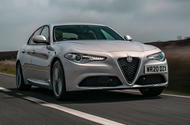Italian compact exec still delivers on driver appeal, even if the updated interior isn’t quite on par with the class best
If you have designs on the new BMW 3 Series, it would be plain ignorant not to drive the Alfa Romeo Giulia, which has been lightly but meaningfully updated for 2020. In a diminishing field, both cars are sold on the idea that style and keen handling are at least as important as fuel economy and how smoothly that all-important infotainment touchscreen works. In each case, it’s also possible to spend more on extremely powerful versions with more than 500bhp, but the point with these cars is that even less exalted derivatives with only around 200bhp should still deliver solidly enjoyable rear-drive saloon dynamics. The Giulia Sprint tested here is one of those less exalted derivatives, although, at more than £37,000, it might not immediately seem that way. It means the Alfa costs more than the 320i M Sport it goes directly up against, although 197bhp and 243lb ft give it an edge on paper and the resulting 6.6sec sprint to 62mph is stronger than most at this level.If that still isn’t strong enough, £42,575 buys the Giulia Veloce, which is fitted with the same 2.0-litre engine but tuned to a healthy 276bhp. These cars are identifiable by their larger teledial wheels and more aggressive styling for the bumpers, although even the Sprint hardly lacks visual clout.The Sprint will also be quick enough for most people, and when you factor in an eight-speed automatic gearbox (sourced from ZF) and plenty of aluminium in the suspension (unusually for the class, the Giulia essentially gets double wishbones at the front), no one can accuse this car of skimping on the hardware. Inside, plenty of small changes have added up to create an ambience that’s much more threatening to the hitherto untouchably slick 3 Series and Audi A4. Admittedly, there is still a small deficit in perceived quality, but many of the cheaper plastics have been replaced and our test car had an array of interesting and widely varying textures, despite the monochromatic colour scheme. Monochromatic, that is, apart from the new tricolore motif at the base of the gear selector. It’s a small but likeable detail that shows the Italians have lost none of their enthusiasm for debecking home-grown cars with the national colours (see Lamborghini Huracán Performante, Ferrari 360 Challenge Stradale, Fiat 500). Elsewhere, the 8.8in central display (now touch-sensitive) is as neatly integrated into the dashboard as ever, and new software means the menus are more easily navigable and, frankly, intelligible. The new smartphone mirroring is also useful, with Android Auto filling the screen generously and the new-and-improved rotary controller atop the transmission tunnel feeling more satisfying to use.
Source: Autocar
